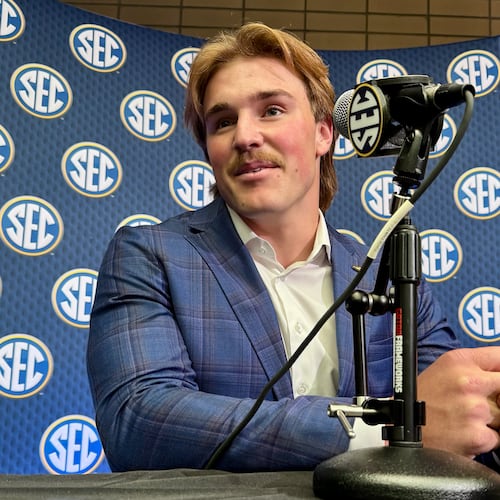RICHMOND, Va. – Along with the legacy of mayhem and the record for protecting the end zone as they would their own homes, there is a shadow that follows members of the Falcons’ 1977 Grits Blitz defense.
Aging voices that delight in the retelling of old glories go soft and wistful when talk turns to Ray Easterling.
He was their free safety, filled to overflowing with all the careless disregard for body and bone that position requires.
He is that flicker of dread whenever one of them may walk into a room and forget why it was he went there, or when some name once so familiar slips his mind.
Easterling is both the example of what made that ’77 defense so fearsome and of what the toll of football legacy-building can be, at its steepest.
It’s like it says on one of the game balls Easterling’s widow, Mary Ann, has stowed away in the Virginia home where five years ago she discovered her man chose to escape the fog of traumatic brain disease and dementia by killing himself:
“Ray Easterling
Falcons 17, Rams 6
September 18, 1977
You Paid The Price”
The true price paid in Easterling’s case was deferred through the years, in the form of a slow, steady mental decline and often dark and disturbing changes in personality, the likely result of a concussion-filled career. As he began to lose his moorings to all that was familiar, Easterling grew quietly desperate. Three days after he was unable to find his way home after running a simple errand, Easterling took his life at the age of 62. The note he left – like his sport’s ultimate relationship with the violence it does the brain (chronic traumatic encephalopathy) – largely was a puzzle.
At 6-foot, 190 pounds, Easterling may have generated more ferocity per square inch than any other member of that ’77 defense.
“Ray stuck his head in there brutally,” said Jeff Merrow, one of that team’s defensive linemen. “He went in there screaming. There was no fear in that man at all.”
“He didn’t do anything halfway,” said his wife, Mary Ann Easterling.
In the years spent coping with her husband’s dementia and death, Mary Ann acknowledges the fierceness with which he played. But she chooses to freeze in her mind more the memories of the devout man she met at a Bible-study class, the natural leader and the charismatic public speaker.
“It was really a blessing to be married to him. We agreed on how we wanted to raise our daughter, how we wanted to have our lives. We wanted to follow and serve Jesus. I choose to focus on that now,” she said.
Easterling and his Grits Blitz brother Fulton Kuykendall – the linebacker affectionately known as Kaptain Krazy – were among the initial group of players to file suit against the NFL in 2011, claiming the league misinformed its players about, and failed to properly protect them against, head trauma. Multiple members of that team were among the more than 5,000 former players who were part of the suit settled by the league, not finalized until this year, which set aside as much as a $1 billion pool for the care of severe neurological diseases, ranging from dementia to Lou Gehrig’s Disease.
None has collected on the award yet, but have gone through all the initial stages of baseline testing from which they can then monitor any worsening of brain function. The largest sports settlement in history has been bogged down as many grasping hands – lawyers and others claiming to represent the players’ interests – are reaching for a piece of such a massive pie.
Not that collecting is necessarily a good thing.
“I hope I don’t get any money just because I don’t want to have that disease,” Kuykendall, 64, said. The symptoms he showed at the beginning of this decade – insomnia, headaches – have steadily persisted through today.
It’s a nagging kind of uncertainty of what their years in football may or may not have wrought, another on the list of medical anxieties with the knees that have been/should have been replaced and the outbreaks of arthritis within some overtaxed joint. These players now in their 60s and 70s try to weigh the usual ravages of aging against those that must be football-induced.
“You know how you walk into a room and say, ‘What did I come in here for?’ You chuckle,” said Rolland Lawrence, 66, the All-Pro cornerback on the ’77 Falcons. “Now, it’s not as funny as when you were younger.”
As players, these Grits Blitzers lifted weights and ran gassers to keep themselves in shape. As retired players, mindful of the growing evidence that football may be harmful to the brain, they find themselves doing a different kind of exercising in the hopes of maintaining their wits.
Hall of Fame defensive end Claude Humphrey, 73, says playing checkers helps. “I’m trying to keep my memory. I’m having some trouble concentrating on memory things,” he said.
Linebacker Greg Brezina, 71, has found a way to intertwine his work as a Christian counselor with his need to stimulate his grey matter. “For 20 years in a row I’ve read the Bible all the way through. I memorize books of the Bible. What I’m thinking is that my brain has found other ways to compensate for the damage I’ve done to it,” he said.
“We’ll find out after I die,” Brezina said. He would like for his brain to be sent to the Boston University CTE Center for study.
Lawrence still substitute teaches on occasion, with the thought of keeping his brain active and battling possible CTE.
“No question, that’s something I may have to deal with down the road,” he said matter-of-factly.
In the last year of his life, during a 2011 interview with a Richmond NBC affiliate, Easterling said he then regretted playing professional football instead of going directly into business after college. "It's such a short window of time to struggle with something for 30 years," said Easterling in that interview. "It's not worth the trade off."
Those still discovering what the full impact of their career choice might be tend to hedge any regrets.
“If I knew then what I know now, I don’t know if I’d play,” Brezina said. “Going back to playing when I was, playing with the information we had, though, we had a blast.”
Easterling was among a handful of former players – such as former Falcon Shane Dronett, former Bulldog Paul Oliver, Junior Seau, Dave Duerson and Terry Long – who committed suicide and later were found to have CTE.
Easterling began showing signs of trouble roughly a decade after retiring from the Falcons in 1980. In ’89, he left a successful position at a term-life insurance and investment firm to pursue other business interests. Nothing quite took. Meanwhile, the always punctual and buttoned-down man began showing up late to meetings and speaking irrationally.
As his condition worsened, his moods changed like the weather, turning stormy with seemingly no provocation. “Life was a continual conflict with him,” Mary Ann said.
When he was diagnosed with dementia in early 2011, “it was a relief in the sense I finally had a reason for all this taking place,” his wife said.
Always a fitness fanatic, Easterling attempted to stall the condition through exercise, but could not ward off the loss of himself.
His roommate with the Falcons, Brezina, gave the eulogy at Easterling’s funeral, stressing that the man they were burying that day was not the same one he knew while they were setting records for scoring defense.
As she came to grips with her husband’s death, and the jumble of emotions it sparked within her, Mary Ann became a source for other players’ wives who were caught up in the turmoil of suspected CTE.
If she watches football today, it’s with an eye toward the people playing, not the game itself. A music instructor and director of an academy that partners with home-schoolers, Mary Ann has been known to try to warn parents away from having their sons play football. As a witness to the price paid, she commands a convincing voice.
With her own family, there is no uncertainty.
Football will go on. New glory will have its day.
But it will, emphatically, do so without Ray Easterling’s grandson.
About the Author
Keep Reading
The Latest
Featured



